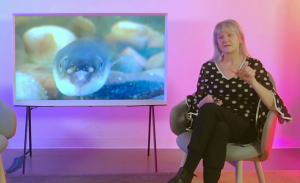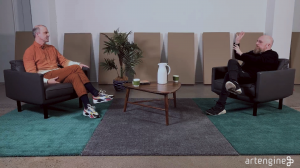Joanna Berzowska explores the realm of electronic textiles, a subset of wearables. She introduces the broad spectrum of projects within this field, from electronic tattoos to biometric shirts. Berzowska advocates for exploring textiles beyond wrist-worn devices, emphasizing her efforts to integrate sensors into traditional textiles. She underscores the importance of respecting manufacturing traditions while incorporating new technologies. Challenges include overcoming a product-oriented mindset and embracing the complexity of electronic materials. Berzowska envisions leveraging existing manufacturing infrastructure and interdisciplinary collaboration to shape the future of materiality. Throughout the talk, she offers insights into the innovative potential of electronic textiles and the intersection of technology and craftsmanship.
This presentation was part of the symposium Unhanded. In this panel we ask about the variety of new relationships with materials that emerging with the increasing ubiquitousness of digital technologies. With the increased complexity of tools we wonder how do we learn about materials? How do we get to know them? How do we share this knowledge? We can now know the molecular structure of wood or metal without touching it. Is this a more intimate relationship than working directly with our hands? Does it matter? If the objects coming out of digital and mechanical processes are more removed from our handywork, how might they carry the mark of the machine? Should we be able to read the machine in the material?
Joanna Berzowska is Assistant Professor of Design and Computation Arts at Concordia University and a member of the Hexagram Research Institute in Montreal. She is the founder and research director of XS Labs, where her team develops innovative methods and applications in electronic textiles and responsive garments.
Her art and design work has been shown in the Cooper-Hewitt Design Museum in NYC, the V&A in London, the Millenium Museum in Beijing, various SIGGRAPH Art Galleries, ISEA, the Art Directors Club in NYC, the Australian Museum in Sydney, NTT ICC in Tokyo, and Ars Electronica Center in Linz among others.
She lectures internationally about the field of electronic textiles and related social, cultural, aesthetic, and political issues. She was recently selected for the Maclean’s 2006 Honour Roll as one of “thirty nine Canadians who make the world a better place to live in”.
She received her Masters of Science from MIT for her work titled Computational Expressionism and subsequently worked with the Tangible Media Group of the MIT Media Lab and cofounded International Fashion Machines in Boston. She holds a BA in Pure Math and a BFA in Design Arts.
Weaving, knitting, those are very complex technologies that have been around for hundreds, even thousands of years that actually contribute a lot to the integrity of the objects that we make.
I work with electronic textiles, which are a subset of this field of wearables. As Valerie Lamontagne described, this is a term that actually encompasses an extremely broad range of projects and practices. Everything from these like sticker sticker like electronic tattoos to collaborative design experiments. It’s actually a term that is really used for a very, very broad multitude of different work that relates to the body. The current commercial reality, though, is really still grounded in what we and we see in the venture capital world call the early adopters. So usually males of a certain age and socio economic class who do a lot of exercise and want to track their performance, their fitness levels. So those are various devices that are usually wrist worn these days, then connect to apps that track, analyze, compare and link to social media. Other than these wrist worn devices. There have been some experiments in penetrating the rest of the body through jewelry like straps, head mounted displays, etc.. But in general, the commercial field of wearables is still deeply anchored in this industry. Really design device reality. So my work, in contrast, has been to focus on the rest of the body. So to actually engage with everything beyond the wrist, I even talk about beyond the wrist interaction and therefore to specific only look at textiles, which are materials we already engage with on our bodies on a day to day basis.
Weaving, knitting, those are very complex technologies that have been around for hundreds, even thousands of years that actually contribute a lots to the integrity of the objects that we make. So by using and respecting these histories of making, but adding new kinds of fibers and coatings and processes, we can actually create these objects that have additional functionalities. So not only clothing our body, you know, these these on signal shirts also have antimicrobial treatment so they don’t smell too bad with you sweating them a lot. They also are these circular knits that help you with your posture. So they have a lot of traditional textile functionality as well as some of this digital textile functionality insofar as they give you a very accurate signal of your heart activity, not just your heartrate, but your full heart signal as well as your breathing and your movement, etc., that will allow you to reach develop new insights into your into your body. What’s happening? The current applications deal with sports, but there is huge potential both on the utopic and dystopic end of things for crowdsourcing this information to develop deeper insights for either good or nefarious purposes. Beyond this idea of the quantified and this is where my pet peeve comes in working with students, working with designers in my many collaborations, my main pet peeve is as soon as we engage with these new materials, with this materiality that allows us to develop electronic, interactive mediated kinds of garments, I find that our minds slip into a product kind of mindset. So even view the full the there are created smell like products. They don’t smell like craft anymore. What do I mean by that is the concept becomes simpler. So working with this new materiality, these smart textiles, these interactive textiles, suddenly it’s not just about the pleasurable, bizarre experience. And this is work from my research lab Access Labs, where we actually try to still engage with these very experimental. These are energy generating garments that are, by their very nature, uncomfortable. This one is called Itchy, and it’s very itchy. And as you move and you scratch yourself, you actually generate energy. Right? And the energy then powers these lights around your neck, which references kind of like safety beacons and the state of emergency and actually highlights the discomfort of the garments.

Cheryl L’Hirondelle presents the process and ideas behind her new work Nipawiwin Akikodjiwan: Pimizi ohci, shown for the first time as part of our Entanglements exhibition. The work is a immersive AV installation about (and with) the eels and their challenges in the context of our local hydroelectric dam on the Ottawa River. L’Hirondelle discusses how her relationship with the falls evolved as she discovered the existence of eel ladders designed to help the endangered animals on their journey through the river.

In this conversation Tim Maughan chats with us about digital infrastructure, the role of organized labour in the creative landscape, and the DEL project Artwork_Local404. Join us, as we discuss technology and capitalism, the benefits of organizing, and what form collective action might take. Maughan also talks about how we need to rethink many of the platforms of tools of the digital world as public infrastructure: this may change how we understand what the government could do with them.